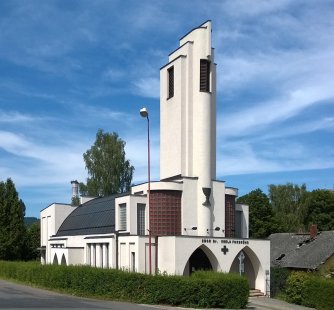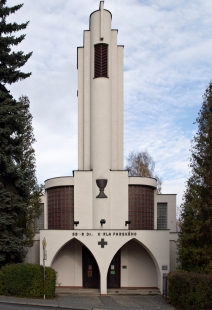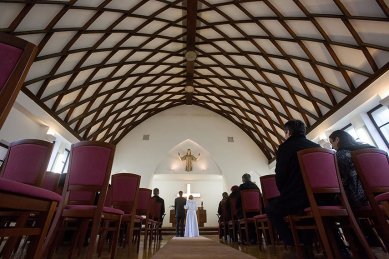
The expressionist church in Semily has become a cultural monument
Semily - The Sbor of Dr. Karel Farský in Semily was declared a cultural monument by the Ministry of Culture at the end of last year. The church represents the most valuable new building of the then Czechoslovak Church among the seven realizations in the Liberec region and one of the most original in the first republic Czechoslovakia. This was stated by heritage conservationist Petra Šternová for ČTK.
"It reflects expressionist tendencies with organic shaping, which is particularly evident in the front facade," she said. The church was built of bricks in 1938 based on the design of Turnov architect Vladimír Krýš. "The central motif of the building is the segmented arch, which is also reflected in the shape of the roof - a laminated structure with a rhombic grid, which also serves as the ceiling," Šternová added. The congregation is located in Podmoklice, a part of Semily, near the railway track by the bus station. Initially, it was supposed to become the dominant feature of the newly designed Podmoklice square, but there was opposition from some local residents. The construction of the church lasted four and a half months. During the tense wartime period, it drew attention in the national press, and even at that time, the chosen architectural solution was praised. The grand opening of the church, less than two weeks before the signing of the Munich Agreement, was also a quiet manifestation for a free republic. The construction of the church with a 24-meter high tower cost nearly 300,000 crowns at that time.
The church is named after the founder of the Czechoslovak Church (now the Czechoslovak Hussite Church) and its first patriarch Dr. Karel Farský. The congregation is open to the public during the Night of Churches and various cultural events, exhibitions, and concerts are held there. Šternová will give a lecture about the monument in the Semily library at the end of February. The building is in very good condition, with a major renovation having taken place from 2002 to 2003. "Even after the general renovation, the church has largely retained its original architectural solution and many original structures and elements, including the gradually supplemented interior equipment," Šternová said.
A decoration of the simple interior, illuminated by high side windows, are relief figures by Vladimír Komárek titled Master Jan Hus on the pulpit and Karel Farský in contemplation of the holy scripture from 1958. "The same author also created the graphic sheets of the Stations of the Cross," the heritage conservationist said. The center of the wall above the chancel is adorned with a sculpture of Christ blessing by Jan Mastník from the 1980s, which replaced the original etched image of Christ's head on black glass. On the sides of the chancel are copper-glazed boxes. On one side, there is earth from the birthplace of Jan Hus from Husinec, along with a piece of stone from the black kitchen and splinters from the floor of the living room, and on the other side, there is earth from the birthplace of Dr. Karel Farský from nearby Škodějov.
"It reflects expressionist tendencies with organic shaping, which is particularly evident in the front facade," she said. The church was built of bricks in 1938 based on the design of Turnov architect Vladimír Krýš. "The central motif of the building is the segmented arch, which is also reflected in the shape of the roof - a laminated structure with a rhombic grid, which also serves as the ceiling," Šternová added. The congregation is located in Podmoklice, a part of Semily, near the railway track by the bus station. Initially, it was supposed to become the dominant feature of the newly designed Podmoklice square, but there was opposition from some local residents. The construction of the church lasted four and a half months. During the tense wartime period, it drew attention in the national press, and even at that time, the chosen architectural solution was praised. The grand opening of the church, less than two weeks before the signing of the Munich Agreement, was also a quiet manifestation for a free republic. The construction of the church with a 24-meter high tower cost nearly 300,000 crowns at that time.
The church is named after the founder of the Czechoslovak Church (now the Czechoslovak Hussite Church) and its first patriarch Dr. Karel Farský. The congregation is open to the public during the Night of Churches and various cultural events, exhibitions, and concerts are held there. Šternová will give a lecture about the monument in the Semily library at the end of February. The building is in very good condition, with a major renovation having taken place from 2002 to 2003. "Even after the general renovation, the church has largely retained its original architectural solution and many original structures and elements, including the gradually supplemented interior equipment," Šternová said.
A decoration of the simple interior, illuminated by high side windows, are relief figures by Vladimír Komárek titled Master Jan Hus on the pulpit and Karel Farský in contemplation of the holy scripture from 1958. "The same author also created the graphic sheets of the Stations of the Cross," the heritage conservationist said. The center of the wall above the chancel is adorned with a sculpture of Christ blessing by Jan Mastník from the 1980s, which replaced the original etched image of Christ's head on black glass. On the sides of the chancel are copper-glazed boxes. On one side, there is earth from the birthplace of Jan Hus from Husinec, along with a piece of stone from the black kitchen and splinters from the floor of the living room, and on the other side, there is earth from the birthplace of Dr. Karel Farský from nearby Škodějov.
The English translation is powered by AI tool. Switch to Czech to view the original text source.



0 comments
add comment






